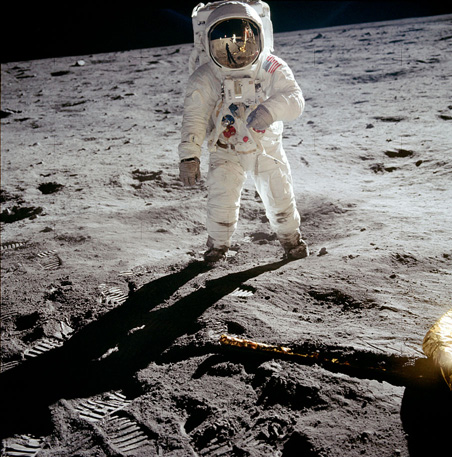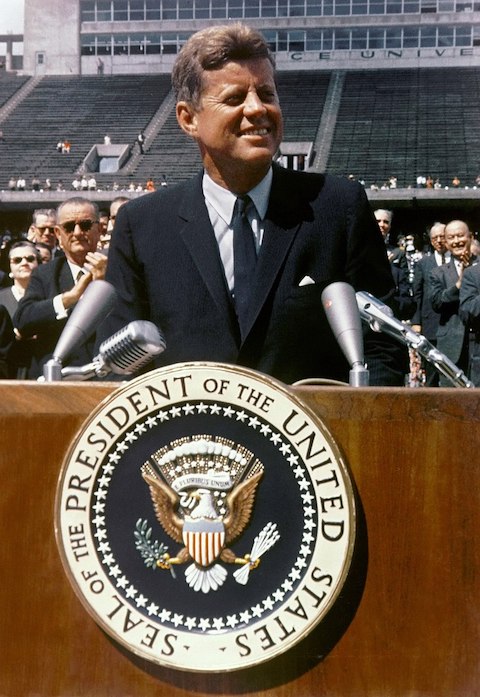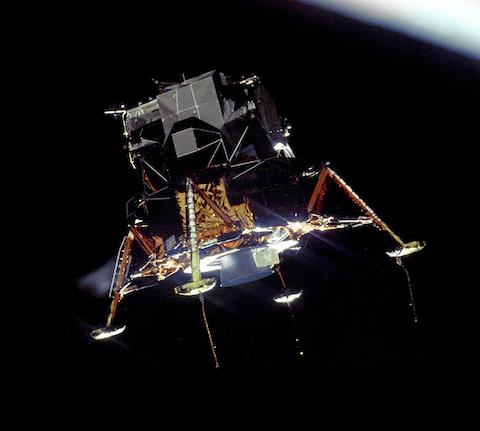
In 1957, the Russians launched Sputnik, the first satellite to orbit Earth.
The U.S. responded by forming NASA, and the Space Race had begun.
The Russians took the lead 4 years later when they sent a cosmonaut into orbit.
President Kennedy conferred with U.S. experts; several were leading German rocket scientists who had emigrated after the war. They designed a program around U.S. strengths.
In May of 1961, Kennedy announced their bold ambition: “before this decade is out, of landing a man on the Moon and return him safely to the earth”.
America had succeeded in rapid, large-scale initiatives before: the Panama Canal, tooling up to build planes at the start of World War II, and nuclear weapons at the end of it.
NASA’s Project Gemini, from 1961 to ‘66, developed capability, mastering orbital flight and testing equipment, techniques and astronauts.
Project Apollo began in 1967 with a tragedy. The three-man crew of Apollo 1 died in a launch pad fire.
Undeterred, later missions quickly followed. By Apollo 8, astronauts were testing lunar modules in Earth orbit. Apollo 10 was a test flight all the way to the Moon without landing on it.
In July of 1969, Apollo 11 amazingly achieved Kennedy’s dream when Neil Armstrong made his “one small step for man, one giant leap for mankind”—proof that a lofty goal can rally a nation to greatness.
Background
Synopsis: On May 25, 1961 President John F. Kennedy addressed a special joint session of Congress, declaring the goal of landing a man on the Moon and returning him safely to the Earth within the decade. This daring goal drove a tremendous pulse of American innovation in technology and science, ultimately confirming the nation’s global leadership. On July 20, 1969, Neil Armstrong realized Kennedy’s goal, making his historical statement “one small step for a man, one giant leap for mankind” as he stepped onto the Moon’s dusty surface, televised for all the world to see.
- During the rivalry of the Cold War (1947–1991), the Soviet Union and the United States competed on many levels, from sports to the Space Race.
- The USSR launched Sputnik 1 into Earth orbit on October 4,1957, demonstrating the threat of Soviet military technology and shocking the United States military.
- The Soviet success surprised the United States and prompted the creation of the National Aeronautics and Space Administration (NASA) by President Dwight Eisenhower. Hoping to get a man into space before the Soviets, NASA launched Project Mercury.
- However, in another Soviet surprise, on April 12, 1961, Cosmonaut Yuri Gagarin completed a single Earth orbit in 1 hour and 48 minutes in his capsule Vostok 1, becoming the first human in space before landing safely in western Russia.
- On May 5, 1961, Alan Shepard became the first American in space. However, he flew just 116 miles high during a 15-minute suborbital journey before splashing down in the Atlantic. It was not the same level of accomplishment as Gagarin’s orbit, and the United States was chagrined.
- Within weeks of the two flights, on May 25, 1961, President John F. Kennedy addressed a special joint session of Congress on “Urgent National Needs,” proposing a bold goal for the United States, saying:
- “I believe that this nation should commit itself to achieving the goal, before this decade is out, of landing a man on the Moon and returning him safely to the Earth. No single space project in this period will be more impressive to mankind, or more important for the long-range exploration of space; and none will be so difficult or expensive to accomplish. We propose to accelerate the development of the appropriate lunar space craft. We propose to develop alternate liquid and solid fuel boosters, much larger than any now being developed, until certain which is superior. We propose additional funds for other engine development and for unmanned explorations—explorations which are particularly important for one purpose which this nation will never overlook: the survival of the man who first makes this daring flight. But in a very real sense, it will not be one man going to the Moon—if we make this judgment affirmatively, it will be an entire nation. For all of us must work to put him there.”
- Kennedy’s audacious bet on American ingenuity was not just talk.
- Before his announcement, the idea was vetted with key experts and fashioned to take advantage of existing American strengths to achieve a seemingly impossible goal in less than 10 years.
- America had prevailed in similar fast-paced challenges with huge scope in the past, including taking over completion of the Panama Canal (1904–1914) and developing nuclear weapons during the wartime Manhattan Project (1942–1946).
- In a speech at Rice University in Houston, Texas, on September 12, 1962, Kennedy explained his rationale:
- “We set sail on this new sea because there is new knowledge to be gained and new rights to be won, and they must be won and used for the progress of all people. For space science, like nuclear science and all technology, has no conscience of its own. Whether it will become a force for good or ill depends on man, and only if the United States occupies a position of pre-eminence can we help decide whether this new ocean will be a sea of peace or a new terrifying theater of war. I do not say that we should or will go unprotected against the hostile misuse of space any more than we go unprotected against the hostile use of land or sea, but I do say that space can be explored and mastered without feeding the fires of war, without repeating the mistakes that man has made in extending his writ around this globe of ours.
- “There is no strife, no prejudice, no national conflict in outer space as yet. Its hazards are hostile to us all. Its conquest deserves the best of all mankind, and its opportunity for peaceful cooperation may never come again. But why, some say, the Moon? Why choose this as our goal? And they may well ask, why climb the highest mountain? Why, 35 years ago, fly the Atlantic? Why does Rice play Texas?
- “We choose to go to the Moon. We choose to go to the Moon...We choose to go to the Moon in this decade and do the other things, not because they are easy, but because they are hard; because that goal will serve to organize and measure the best of our energies and skills, because that challenge is one that we are willing to accept, one we are unwilling to postpone, and one we intend to win, and the others, too.”

- The challenge of a crewed mission to the Moon would require enormous expenditure and effort, but it inspired and supercharged American innovation.
- Project Gemini (1961–1966) paved the way, extending spaceflight capability with development of techniques for space travel. In 5 years, 16 one-man and 10 two-man crews performed critical experiments to determine limits of mission endurance, ways to undertake activity outside of a space vehicle without tiring, and orbital maneuvers for rendezvous and docking with another spacecraft.
- Project Apollo (1961–1972) started off with tragedy when the crew of Apollo 1 (Grissom, White, and Chaffee) died in a January 1967 cabin fire during a rehearsal for a February launch.
- Apollo 2 and Apollo 3 were cancelled, but Apollo 4, 5, and 6 were successful unmanned flights designed to test the command and lunar modules.
- Apollo 7, designed to test the command module, was the first crewed Apollo mission. Apollo 8 and Apollo 9demonstrated operability of both modules in Earth orbit.
- Apollo 10 was a complete test mission to the Moon that only stopped short of landing on the lunar surface.
- Apollo 11 finally achieved Kennedy’s goal of landing a man on the Moon and returning him safely to the Earth.
- On July 20, 1969, Neil Armstrong and Edwin “Buzz” Aldrin landed the lunar module, Eagle, in the Sea of Tranquility, while Michael Collins orbited the Moon from the Command Service Module, Columbia.
- Upon stepping on the soft surface of the Moon, Neil Armstrong said “That’s one small step for a man, one giant leap for mankind.”
- Before the Apollo 11 astronauts could take their steps on the Moon, they had a lot to learn. Among other training courses, the crew of Apollo 11 and other astronauts attended Geology Field Camp.
- The six later Apollo missions focused on scientific investigation of the lunar surface, both from the lunar module and from the orbiting command module.
- We will talk more about astronaut training and scientific exploration in a future EarthDate.

- Technological innovation had made the impossible possible. Even though he didn’t live to see the results of his challenge, Kennedy had inspired Americans to achieve this grand vision through imagination, ingenuity, focused engineering, and hard science.
- Today, the term “moonshot” refers to a huge problem that requires radical solutions and disruptive technology to solve…like getting a man to the Moon would have been in 1961.

